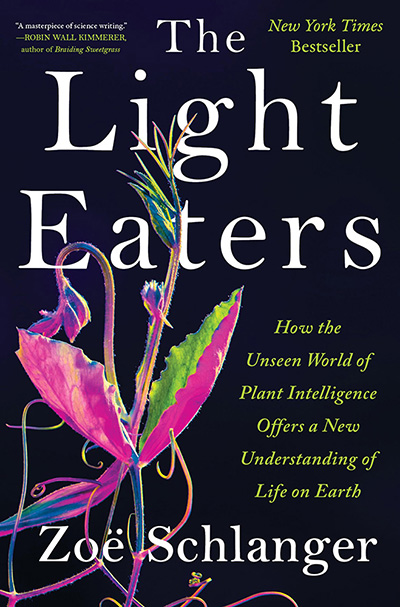The new year calls for a new take on how we appreciate plants, the foundation of all life on earth. Journalist Zoë Schlanger assembles exactly that in her shape shifting book, Light Eaters, How the Unseen World of Plant Intelligence Offers a New Understanding of Life on Earth.
The 290-page best seller shares a massive collection of research, facts and thoughtfulness in a readable narrative that makes the compelling case that plants can see, hear, think and feel.
Yes, that’s correct. Plants have feelings and other forms of intelligence. Scientists have known this for decades, but resisted the notion because the vocabulary we apply to explaining these phenomena is often viewed as anthropomorphizing. In addition, humanity in general is guilty of “plant blindness,” the tendency to view plants as an indistinguishable mass rather than the thousands of genetically unique individuals that they are. Schlanger explores the scientific strife resulting from this disconnect as an ongoing thread in the book, sharing how she must tread lightly with certain scientists in the way she speaks about plant sentience, lest they refuse to share their insights with her.
Plants can hear, they can sense, they even willingling morph themselves to look like their neighbors, as does the Boquila trifolioata, a unique vine that grows in Chile and Argentina. The boquila literally has the capacity to impersonate its host plant, transforming its leaf shape and general appearance to replicate that of the plant on which it is growing.
Why does it do this? We don’t know. But boquila conducts these metamorphoses within single generations–what Schlanger labels “spontaneous mimicry”–not centuries or millennia.

Boquila trifolioata in the Chilean forest. –Photo by Cristian Riquelme, via Wikimedia Commons
In the Chilean forest, Schlanger witnesses the boquila mimicking plants. After observing its impressive imitations on a forest walk, she notes the boquila is “treating the other plants like a living patent library, where all the patents are free to use–at least for the boquila.”
Schlanger tackles all the senses of plants, chapter by chapter, challenging conventional thought about how we think about them. In chapter five, called “An Ear to the Ground,” she describes how plants respond to audio vibrations, the equivalent of hearing. They notice the sound of caterpillars chewing on their foliage and release chemicals that taste bad as a defense. They also release other compounds that waft to their fellow plants, warning them to do the same.
Plants use their senses to activate weaponry in acts of self defense–is this not intelligence?
An interesting back story in Light Eaters is the specter of the decades-old best seller, The Secret Life of Plants, published in 1973.
In that book, non scientist plant enthusiasts Peter Tompkins and Christopher Bird explored and offered evidence of plant sentience, often cloaked in psychic speculation and the occult. This book is the one that famously (and to much ridicule) proposed that plants prefer classical music to rock and roll. While many embraced this notion, it’s no surprise that scientists scoffed, dismissing it as pseudoscience and putting the quash on the budding field of plant behaviour.
According to Schlanger’s deeply researched narrative, that’s changing.
In the years following Secret Life‘s publication, the National Science Foundation grew reluctant to fund research studying plant response to their environment. Scientists who had once pioneered the field changed their courses of study, or left science entirely.
But Schlanger notes that a select few held on, waiting for the tide to turn. In the last decade and a half, thanks to genetic sequencing and other advances, it finally has.
Prepare to hear more about the the amazing depth and complexity of plants in the coming years. Recent research has found that plants possess promising indicators of memory, some can distinguish themselves from others, and some are capable of determining who is kin. “When such plants find themselves beside their sibling, they rearrange their leaves within two days to avoid shading them,” giving their family members the advantages necessary to thrive as a light eater, Schlanger writes.
This book will leave you stunned with the amazing capacities of plants and an awareness of the vanity of humanity in dismissing them as lesser beings. HIGHLY RECOMMENDED.
Related posts:
- Childhood dream to become an author comes true with monarch butterfly book
- Poetry and nature writing merge in Aimee Nezhukumatathil’s World of Wonders
- Scientist and naturalist David Hillis provides holistic and enlightening tour of the Texas Hill Country
- Bird is the Word: FREE San Antonio Book Festival panel to explore migration, the wonders of wings
- In Defense of Plants: explorations of the remarkable nature of plants
- Agrawal: Milkweeds don’t need Monarch butterflies, but Monarchs need milkweed



Years ago, I found a copy of The Secret Life of Plants in the trash. Curious, I read a little….and then devoured the book! It was irresistibly interesting! It opened my mind to the miraculous, which is of God, and not to man’s need to
always find scientific explanations of everything! An alternative book title might be “Light Knitters” , where plants, by a process we call ” photosynthesis”, knit light into life! This is a truly miraculous ability !!!
Give Him the Glory!!!
I appreciate your give Him the glory comment. He is truly the creator of all this magnificent beauty. Rom 1: 19-21
Give Him the glory!
Bless you Dr. Jacobson for seeing and glorifying the author of this wonderful natural creation.
If you love plants and how they function, this is a fascinating
read. Agree with Monika’s recommendation.
I have known for several years that once caterpillars start eating their host plant that all the same plants will send out a message to bring in the predators to remove them. And I’ve seen it happen in my garden.